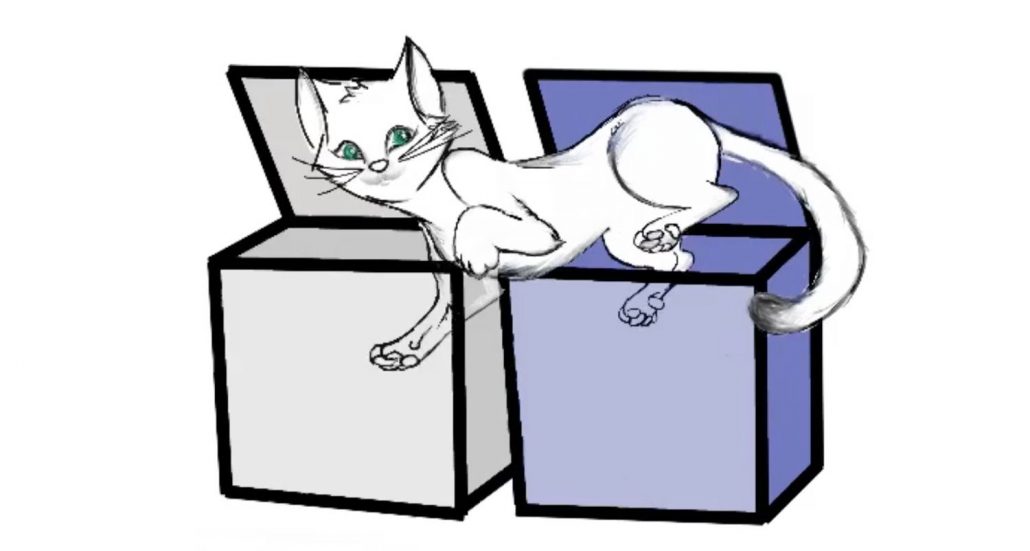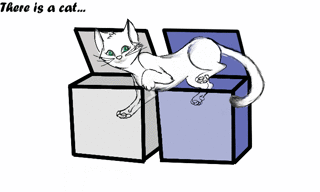Famous physics cat now alive, dead and in two boxes at once
Splitting the feline between boxes is a step toward building microwave-based quantum computers

The infamous (and fictious) Schrödinger’s cat, is always both alive and dead inside a box — until the box is opened. Then the truth comes out.
Yvonne Gao, Yale University
Physicist Erwin Schrödinger’s cat can’t seem to catch a break. The fictitious feline is famous for being alive and dead at the same time, as long as it remains hidden inside a box. Scientists think about Schrödinger’s cat in this way so that they can study quantum mechanics. This is the science of the very small — and the way that matter behaves and interacts with energy. Now, in a new study, scientists have split Schrödinger’s cat between two boxes.
Animal lovers can relax — there are no actual cats involved in the experiments. Instead, physicists used microwaves to mimic the cat’s quantum behavior. The new advance was reported May 26 in Science. It brings scientists one step closer to building quantum computers out of microwaves.
Schrödinger dreamt up his famous cat in 1935. He made it the unfortunate participant in a hypothetical experiment. It’s what scientists call a thought experiment. In it, Schrödinger imagined a cat in a closed box with a deadly poison. The poison would be released if some radioactive atoms decayed. This decay occurs naturally when a physically unstable form of an element (such as uranium) sheds energy and subatomic particles. The math of quantum mechanics can calculate the odds that the material has decayed — and in this case, released the poison. But it cannot identify, for certain, when that will happen.
So from the quantum perspective, the cat can be assumed to be both dead — and still alive — at the same time. Scientists called this dual state a superposition. And the cat remains in limbo until the box is opened. Only then will we learn if it’s a purring kitty or a lifeless corpse.
Scientists have now created a real laboratory version of the experiment. They created a box — two actually — out of superconducting aluminum. A superconducting material is one that offers no resistance to the flow of electricity. Taking the place of the cat are microwaves, a type of electromagnetic radiation.
The electric fields associated with the microwaves can point in two opposite directions at the same time — just as Schrödinger’s cat can be alive and dead at the same time. These states are known as “cat states.” In the new experiment, physicists have created such cat states in two linked boxes, or cavities. In effect, they have split the microwave “cat” into the two “boxes” at once.
The idea of putting one cat into two boxes is “kind of whimsical,” says Chen Wang. A coauthor of the paper, he works at Yale University, in New Haven, Conn. He argues, however, that it’s not that far off from the real-world situation with these microwaves. The cat state is not only in one box or the other, but stretches out to occupy both. (I know, that’s weird. But even physicists acknowledge that quantum physics tends to be weird. Very weird.)
What’s even weirder is that the states of the two boxes are linked, or in quantum terms, entangled. That means if the cat turns out to be alive in one box, it’s also alive in the other. Chen compares it to a cat with two symptoms of life: an open eye in the first box and a heartbeat in the second box. Measurements from the two boxes will always agree on the cat’s status. For microwaves, this means the electric field will always be in sync in both cavities.

The scientists measured how close the cat states were to the ideal cat state they wanted to produce. And the measured states came within roughly 20 percent of that ideal state. This is about what they would expect, given how complicated the system is, the researchers say.
The new finding is a step toward using microwaves for quantum computing. A quantum computer makes use of the quantum states of subatomic particles to store information. The two cavities could serve the purpose of two quantum bits, or qubits. Qubits are the basic units of information in a quantum computer.
One stumbling block for quantum computers has been that errors will inevitably slip into calculations. They slip in because of interactions with the outside environment that muck up the qubits’ quantum properties. The cat states are more resistant to errors than other types of qubits, the researchers say. Their system should eventually lead to more fault-tolerant quantum computers, they say.
“I think they’ve made some really great advances,” says Gerhard Kirchmair. He is a physicist at the Institute for Quantum Optics and Quantum Information of the Austrian Academy of Sciences in Innsbruck. “They’ve come up with a very nice architecture to realize quantum computation.”
Sergey Polyakov says this demonstration of entanglement in the two-cavity system is very important. Polyakov is a physicist at the National Institute of Standards and Technology in Gaithersburg, Md. The next step, he says, “would be to demonstrate that this approach is actually scalable.” By this, he means that it would still work if they added more cavities to the mix to build a bigger quantum computer.







